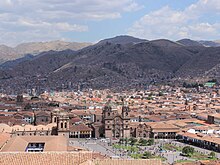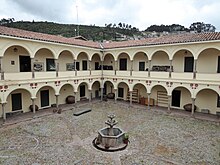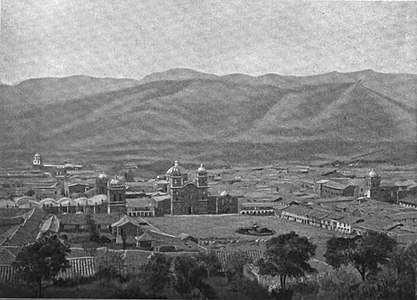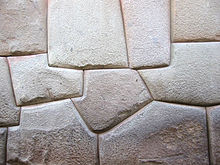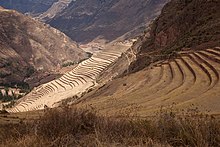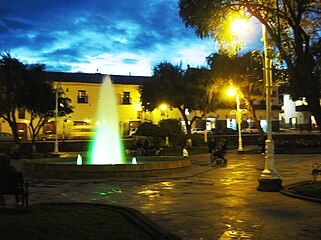Cusco
| Cusco | |
|---|---|
|
Coordinates: 13 ° 31 ′ S , 71 ° 59 ′ W
Cusco on the map of Peru
|
|
|
Townships
|
|
| Basic data | |
| Country | Peru |
| region | Cusco |
| province | Cusco |
| City foundation | circa 11th century |
| Residents | 111,930 (2017) |
| - in the metropolitan area | 428.450 |
| City insignia | |
| Detailed data | |
| surface | 385 km 2 |
| Population density | 291 inhabitants / km 2 |
| height | 3416 m |
| Post Code | 08000 - 08215 |
| prefix | 084 |
| Time zone | UTC -5 |
| City Presidency | Luis Flórez García |
| Website | |
| Central square of Cusco, Peru | |
Cusco (outside of Peru usually Cuzco ; in Quechua Qusqu or Qosqo ; in German historically also Kusko ) is the capital of the region of the same name and the province of Cusco in the center of the Peruvian Andean highlands. It is located at an altitude of 3416 m and, in the 2017 census, had 111,930 inhabitants in the urban area and 428,450 in the metropolitan area. It is the seat of the Archdiocese of Cuzco and a university . The historical importance as the capital of the Inca empire , the pre-colonial and colonial monuments and sights in the city and its surroundings and the location in the middle of the Andes make it an attraction for many tourists .
In 1983 the Andean city was added to the list of UNESCO World Heritage Sites . Cusco is also the starting point for excursions to the long hidden Inca city of Machu Picchu, about 100 kilometers away .
Surname
The name of the city is Quechua ( Qusqu , pronunciation: ['qos.qɔ]). The word is often assigned the meaning "center of the world" or "center of the world". It is possible that it originally came from the Aymara and was shortened from the name qusqu wanka ("rock of the owl"). According to a founding myth of the city, a winged creature settled at the place where the city was later founded and was turned into stone there.
In Spanish , the name was written in the spelling Cuzco , Cozco or Cusco . The most common spelling in Peru today is Cusco , in the rest of the Spanish-speaking area Cuzco . In 1976, by order of the mayor, Cusco was ordered as the official spelling. On June 23, 1990, it was also decided to change the spelling in Quechua in order to approximate it to the Quechua variety and spelling common in Cusco. Since then, the spelling Qosqo has been mandatory for city government documents written in Quechua .
history
Inca period
According to legend, the first Inca Manco Cápac , son of the sun, founded the city with his sister Mama Ocllo . Previously, the area is said to have been inhabited by the Tampu, a Quechua people . It certainly belonged to the sphere of influence of the Wari culture , whose center of power fell into disrepair in the 11th century. Based on the traditional list of the 12 Inca rulers, the founding of Cusco was mostly dated to the 11th or 12th century European calendar, for which there was no evidence other than the legendary traditions. Archaeologically, the development of the settlement into an outstanding urban center is estimated today around the period between 1250 and 1310, when a regional dry phase forced agriculture to intensify and a strong increase in population took place. Towards the end of this phase, the city had an area of around 50 hectares , about five times more than comparable settlements in the wider area. At this time, at the latest, the expansion of the Inca Empire began.
The city consisted of two halves, Upper Cusco ( Hanan Qusqu ) and Lower Cusco ( Urin Qusqu ). The first five Inca rulers , who bore the title Sinchi ("warlord", actually "strong"), ruled from Lower Cusco, the subsequent rulers with the title Sapa Inka resided in Upper Cusco. More precise records exist only since the time of the 9th Inca, Pachacútec Yupanqui . During his reign, which is usually dated from 1438 to 1471 according to the chronology established by John Rowe in the 1940s , he expanded the Inca area in the central Andes from Lake Titicaca to Junín . The empire was divided into four parts according to the four cardinal points (in Quechua Tawantinsuyu , tawa - four, suyu - land), its flag was the rainbow flag ( Wiphala ). In Cusco, too, the center of the empire, each of these parts of the empire corresponded to a city quarter. This quarter division was possibly also shown in the Andean cross, the hole in the middle could represent the capital Cusco.
Pachacútec had agricultural terraces ( Inca terrace ) built in the area for the cultivation of maize in order to ensure the supply of the population. Canals to the Saphi (Quechua: "root") and Tullumayu ("Bone River ") rivers , which ran through the entire city, provided the residents with fresh water and kept the city clean. He also had the sun temple Inticancha built in Cusco as an imperial identification center, which was equipped with unimaginable amounts of gold jewelry.
Túpac Yupanqui took over the rule of the empire from his father as the 10th Inca. Under his leadership the Inca empire reached its greatest extent. Through different incorporation methods he was able to expand the empire in the north to Quito in today's Ecuador and in the south to the area of today's Santiago de Chile . East of the Andes, the southern quarter of the Inca empire reached at least as far as the cult city of Samaipata in what is now Bolivia. Under him or his successor, the eastern quarter of the empire advanced to the Guaporé River in what is now the Bolivian-Brazilian border area. High dignitaries of the inferior ethnic groups were sent to Cusco and trained there and then entrusted with important administrative functions in their home regions, which contributed to the development and spread of a unified imperial Inca culture.
Huayna Cápac , the 11th Inca, took over the empire a few decades before the arrival of the Spaniards and drove the expansion especially in the north. He stayed in Quito for a long time and made it a second capital to compete with Cusco. After his death (around 1525), his sons Atahualpa , who resided in Quito, and Huáscar from Cusco fought over the successor. In the years that followed, the conflict escalated into civil war. In 1532 Huáscar was defeated by his brother, who had the more battle-tested troops from the northern territory and war-experienced generals. Atahualpa, now the unrestricted ruler of the Inca Empire, stayed away from Cusco and installed his general Quisquis as governor there. Quisquis had Huáscar's entire family and a large part of the Cusquen Inca nobility killed.
Colonial times and decline
On November 16, 1532, Francisco Pizarro captured Atahualpa in the so-called Battle of Cajamarca . To buy himself free, Atahualpa had immeasurable amounts of gold and silver brought from Cusco to Cajamarca. Pizarro had him killed anyway and moved to Cusco. On November 15, 1533 he took the capital . Cusco initially remained largely undestroyed and was sacked by the Spaniards.
In 1535 Pizarro founded the city of Lima on the Pacific coast , which was much more convenient in terms of transport and was to become the administrative center of the colony. In the same year, the puppet ruler Manco Cápac II, appointed by Pizarro, fled Cusco and organized a large-scale uprising. With over 100,000 men he marched against Cusco and besieged the city for several months. The Spaniards were only able to avoid ruin with a narrow margin and thanks to the reconquest of the Sacsayhuamán fortress . During the siege, Cusco was mainly destroyed by incendiary bullets and was rebuilt in the following years in the colonial style, although the foundation walls from the Inca period and the old street layout were largely preserved. In 1536 Cusco became the seat of a diocese , the second (after Cartagena ) on the South American continent.
Immediately following the suppression of the Inca uprising, civil war broke out among the conquistadors, as both Pizarro and his partner Diego de Almagro laid claims to the city. In the course of the conflict, both Almagro and his son of the same name (executed in Cusco in 1538 and 1542) and his adversary Francisco Pizarro (murdered in Lima in 1541) were killed. Also Gonzalo Pizarro , who led a rebellion against the Spanish crown, was executed in Cusco 1548th
With the reorganization of the colony under royal administration after the civil wars, Cusco finally ceded its former importance to the capital Lima and the neighboring port city of Callao and became a secondary colonial city. Nevertheless, the historical buildings were built during this time that give the old town its character to this day, including numerous churches. The Spanish chronicler Pedro de Cieza de León spread the first authentic information about the city and its inhabitants in his book Crónica del Perú (1553). However, the illustrations for this book are unrealistic fantasy representations.
In Cusco in 1572, on the orders of Viceroy Francisco de Toledo, the last Inca king, Túpac Amaru, was demonstratively beheaded in front of an indigenous audience in order to discourage the former Inca subjects. Also in Cusco in 1781, after a failed uprising, the Indian rebel leader José Gabriel Condorcanqui , who had become known under the name "Túpac Amaru II.", Was quartered .
In 1650 Cusco was destroyed by an earthquake, but the foundations of the palaces and temples built by the Incas, which had withstood the destruction of the war, withstood the earthquake.
In 1692 the University of Cusco was founded, one of the oldest universities in Peru.
During the War of Independence in 1820, Cusco became the capital of the last Spanish viceroy, José de la Serna , while the Republic of Lima was already in power . After independence, Cusco, which is said to have had around 40,000 inhabitants before 1820, increasingly degenerated into an insignificant provincial city, as the Spanish and Creole upper classes emigrated. In 1876 only 18,370 inhabitants were counted; After the catastrophic outcome of the Saltpeter War in Peru in the 1880s, the population continued to decline.
Map of Peru from the first printed America Atlas by C. Wytfliet (1597). Cuʃco is written with a long s .
Plan of old Cuzco
by EG Squier (1877)Kusko from the Colcampata terrace.
Photograph by EW Middendorf (around 1885)
20th century
When the city of Machu Picchu , hidden on a mountain , was discovered in 1911 , the importance of the city changed. Cusco became a center of renewed interest in the Indian past. At the same time, Cusco developed into the largest tourist center in Peru .
Another earthquake in 1950 destroyed the rebuilt churches and houses. Cusco was 90% destroyed. The preserved Inca ruins and the city center with its colonial buildings were declared a World Heritage Site by UNESCO in 1983 .
Attractions
Churches
- The Cathedral of Cusco - It was built from 1560 to 1654 on the foundations of the palace of the 8th Inca Viracocha .
- La Compañía de Jesús - The Jesuit Church was built from 1552 to 1668 on the foundations of the palace of Huayna Cápac. It surpasses the cathedral in pomp and beauty, which led to a church dispute at the time.
- La Merced - The monastery church was built between 1540 and 1600. This is where the 22 kg, golden monstrance is located , which is decorated with 1,518 diamonds, over 600 pearls and countless rubies, emeralds and other precious stones.
- San Francisco - A church with a carved choir and paintings.
- San Blás - A church with a carved pulpit. The most beautiful wood carving in Cusco.
- San Sebastián - A baroque church with a rich ornamental decoration on the inside.
- Santo Domingo - The interior of the Coricancha solar sanctuary was exposed by the 1950 earthquake .
Inca ruins
- Callejón de Siete Culebras - The Alley of the Seven Serpents . Some stones are decorated with snakes, which were a symbol of wisdom for the Incas.
- Calle Hatunrumiyoc ( hatun rumiyuq: "with the big stone") - The wall of the former palace of the ruler Inca Roca . It is an example of the technique of seamlessly blocking huge stones. The most famous stone has 12 corners.
- Sun Sanctuary Coricancha (Qurikancha) - In the sun temple of the Inca there are sloping walls with trapezoidal niches and a 20-sided stone.
Museums
- Museo Inka - fabrics, ceramics, jewelry and everyday objects, as well as mummies and trephined skulls from the Inca period are exhibited here.
- Museo Regional - The museum is located inside a 17th century palace .
- Museo de Historia Regional - Pre-Columbian objects and ceramics from the Chavín , Mochica , Chimú and Nazca cultures are displayed here.
- Museo de Historia Natural - A collection of objects from the regional animal and bird kingdom can be seen here.
- Museo Monasterio de Santa Catalina de Siena . It shows the culture of the women's monasteries in colonial Cusco and the economic autonomy and intellectual self-determination of the nuns in a male-dominated society.
- Museo Machupicchu Casa Concha - A collection of objects from Machu Picchu
Sights in the vicinity
- Sacsayhuamán , ruins three kilometers north on the mountains above Cuzco.
- Tambomachay , a water sanctuary in which the water pours in channels over four terraced levels; 8 kilometers north.
- Puka Pukara , a small mountain fortress with towers, dwellings and stairs, near Tambomachay.
- Q'enko , a fairground with a huge, jagged limestone. A crevice leads into the interior of the rock, where the dead were probably mummified. On the top there is a stone for observing the solstice. A snake-shaped channel is said to have been used in religious rituals for drink and blood sacrifices.
- Cristo Blanco , a white statue of Christ on the hill next to Sacsayhuamán.
Sights in the wider area
- Chinchero - small town in the high plateau NW of Cusco. Colonial church built on Inca ruins. There is an Indian market in Chinchero on Sundays.
- Tipón - Inca ruins with wide terraces and working water channels in the east of the city, near the village of Oropesa.
- Pikillaqta - ruins from the Wari culture , located in the east of the city of Cusco on a protruding range of hills at a narrow point of the Urubamba river (near the confluence with the Río Sapphi ), which was a strategically important place as a natural pass.
-
Valle Sagrado de los Incas ( Sacred Valley of the Incas ) - fertile valley in the north of Cusco, an area characterized by flat alluvial areas a few kilometers wide between steep cliffs, small villages, Inca ruins and surrounded by high snow mountains. Special sights are:
- Urubamba - capital of the province of the same name. The Urubamba river forms the so-called Valle Sagrado in this valley area.
- Písac - A former Inca city about 30 km from Cuzco with a fortification wall, gates and bastions, a huge cemetery, countless terraces and a 16 m long underground passage.
-
Ollantaytambo - A fortress of great religious importance about 70 km from Cuzco. The fortress was not completed until the arrival of the Spaniards. Six huge monoliths made of red granite that weigh up to 50 tons are evidence of this .
 The villages in the Valle Sagrado along the Río Urubamba
The villages in the Valle Sagrado along the Río Urubamba
- Machu Picchu - The Hidden City - The most visited attraction in Peru.
- Circles of Moray - large circular agricultural experiment complex of the Incas, where, among other things, seeds from the Amazon region were found.
Modern Cusco
Tourists can reach Cusco via the airport or using the numerous intercity buses at Terminal Terrestre . PeruRail connects Cusco with Puno and Machu Picchu .
Modern Cusco likes to present itself as a tourist metropolis . In fact, tourism is the largest source of income. The city administration is making enormous efforts to create the necessary infrastructure and to keep the negative effects as low as possible. The architectural city center has hardly changed in the last few decades. Folkloric performances and the original way of life can be experienced in many events and bars.
For the safety of the visitors, a separate tourist police was introduced, which also patrols at night.
Sport and culture
In addition to various special tourism-related cultural events, various events take place for the population: In addition to church holidays (Señor de los Temblores - Lord of the Quakes, Christmas Market, Carnival, Easter and Corpus Christi - Corpus Christi ) also musical (e.g. Festival de la Cerveza) and sporting events, whereby the most famous local soccer club Cienciano del Cusco has grown into an internationally renowned club (winner of the Copa Sudamericana 2003) in recent years (since 2001) . Cusco has football stadiums and a closed Coliseum for sporting and cultural events.
photos
sons and daughters of the town
- Manco Cápac II. (≈1500–1544), Inca ruler after the conquest of the Inca empire and the assassination of Atahualpas by the Spanish conquistadores
- Diego Quispe Tito (1611 – ≈1681), Quechua painter
- Faustino Espinoza Navarro (1905–2000), actor, poet and playwright
- Ricardo Castro Pinto (1916–2011), musician, composer, actor, dancer and collector of traditional songs
- Demetrio Túpac Yupanqui Martínez (1923–2018), professor of Quechua, translator and journalist
- Valentín Paniagua Corazao (1936–2006), Peruvian interim president from 2000 to 2001
- Odi Gonzales (* 1962), poet who writes in Spanish and Cusco-Quechua
- Ciro Quispe López (* 1973), Catholic clergyman, prelate of July
- Frédéric Perreten (* 1978), Swiss composer of Peruvian origin
- Verónika Mendoza (* 1980), psychologist, teacher and politician
Town twinning
Cusco lists the following twenty twin cities :
| city | country | since |
|---|---|---|
| Athens |
|
1991 |
| Baguio |
|
1984 |
| Bethlehem |
|
1993 |
| Chartres |
|
1989 |
| Cuenca |
|
2000 |
| Havana |
|
1993 |
| Jersey City |
|
1988 |
| Jerusalem |
|
1996 |
| Kaesong |
|
1990 |
| Krakow |
|
1988 |
| Kyoto |
|
1987 |
| La Paz |
|
1984 |
| Mexico city |
|
1987 |
| Moscow |
|
1993 |
| Potosí |
|
1998 |
| Rio de Janeiro |
|
2003 |
| Samarqand |
|
1986 |
| Santa Barbara |
|
1992 |
| Santa Rosa de Copan |
|
1996 |
| Xi'an |
|
1998 |
Climate table
|
Average monthly temperatures and rainfall for Cusco
Source: missing
|
|||||||||||||||||||||||||||||||||||||||||||||||||||||||||||||||||||||||||||||||||||||||||||||||||||||||||||||||||||||||||||||||||||||||||||||||||||||||||||||||||||||
Web links
- Official website on Cusco (English)
- Tourist information about u. a. Cuzco on the page rediscover machupicchu (English)
- Entry on the UNESCO World Heritage Center website ( English and French ).
Individual evidence
- ↑ So in 1895 with Ernst Wilhelm Middendorf ( Peru. Observations and studies on the country and its inhabitants. Volume III. The highlands of Peru. Berlin 1895, pp. 462–486, etc.).
- ↑ Peru: Region of Cusco - Provinces & Places . www.citypopulation.de. Retrieved December 19, 2019.
- ↑ Perú: Perfil Sociodemográfico (PDF, 27.4 MB) Instituo Nacional de Estadistica e Informatica (INEI). August 2018. Retrieved December 19, 2019.
- ^ Instituto Nacional de Estadística e Informatica: Census 2007 Peru
- ^ Brian S. Bauer, Douglas K. Smit: Separating the Wheat from the Chaff. Inka Myths, Inka Legends, and the Archaeological Evidence for State Development. In: Izumi Shimada (Ed.): The Inka Empire. A Multidisciplinary Approach (William and Bettye Nowlin Series in Art, History, and Cultur). University of Texas Press, Austin 2015. pp. 67-81 (here esp. 74-78).
- ^ Frank Salomon: Inkas through Texts. In: Izumi Shimada (Ed.): The Inka Empire. A multidisciplinary approach . University of Texas Press, Austin 2015. pp. 23-38 (here: 25, Fig. 2.1).
- ↑ Wolfgang Albers: The Wives of the Sun and the Brides of the Lord. The Museo Monasterio de Santa Catalina in Cusco . In: Frankfurter Allgemeine Zeitung of September 8, 2017, p. R3.
- ↑ Asociación de Agencias de Turismo del Cusco - Ciudades Hermanas de Cusco. Retrieved May 5, 2016 .





